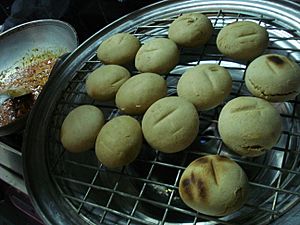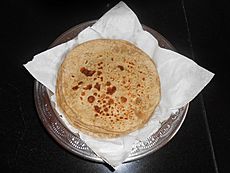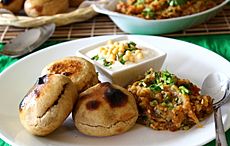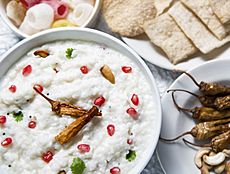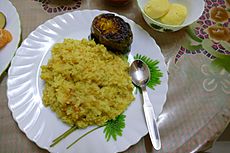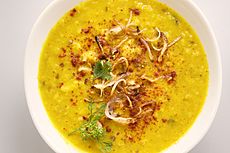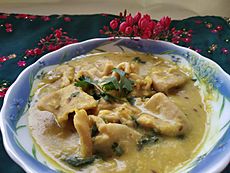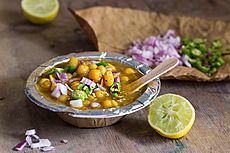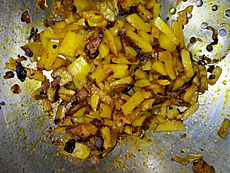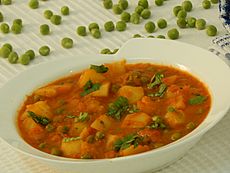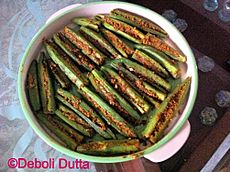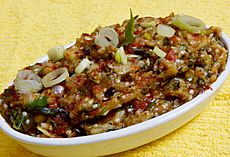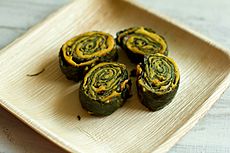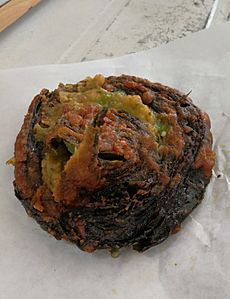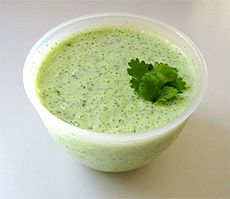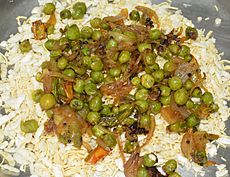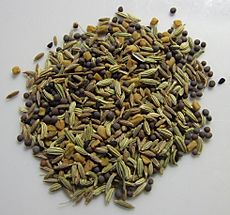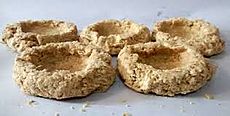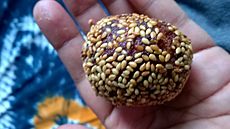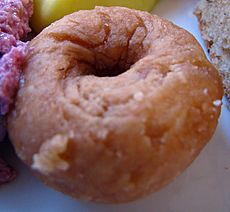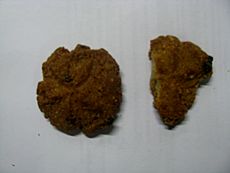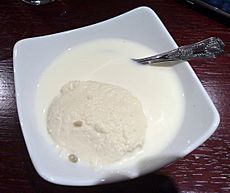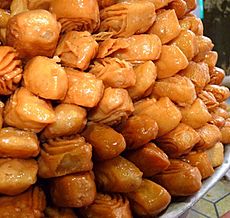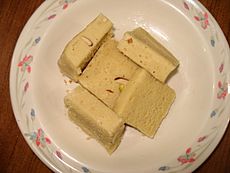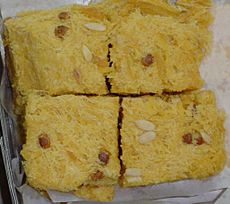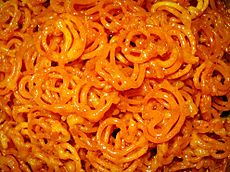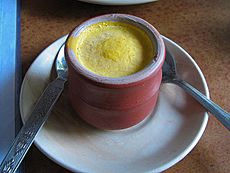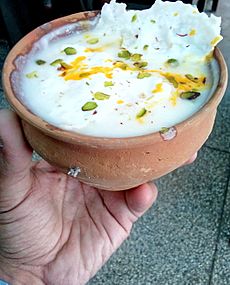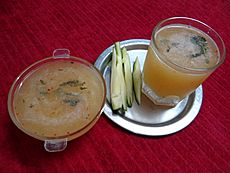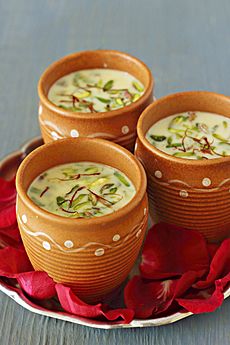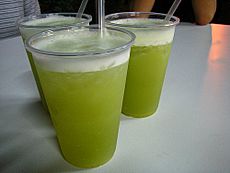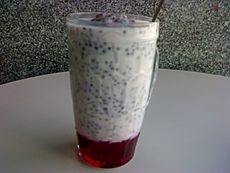Bhojpuri cuisine facts for kids
Bhojpuri cuisine is a style of food preparation common amongst the Bhojpuri people of Bihar and eastern Uttar Pradesh. Bhojpuri foods are mostly mild and are less hot in term of spices used, but could be hotter and spicier according to individual preference.
Bhojpuri people enjoy eating both vegetable and meat dishes.
Contents
Breads
Various kinds of breads are consumed in Bhojpuri cuisine. Roti or chapati is prepared almost every day and eaten in all three meals of the day. Millet breads are also cooked occasionally depending upon the season.
Paranthas (also called paravaathas in western districts of Bhojpur region) are prepared for breakfast. Paranthas are usually stuffed with vegetables, chhena, dal or sattu. Sometimes, layered paranthas with flavourings of spices like ajwain are also prepared.
Occasionally, deep-fried breads like puri, luchui, suhari and kachori are also prepared. Puas (sweet pancakes) are also commonly cooked in monsoon season or on religious occasions.
Some special breads exclusive to the region:
- Makuni/berhai: Puffed wheat bread which is stuffed with sattu and spices and cooked by frying.
- Litti: Litti is a hard, unleavened wheat bread which is eaten along with chokha. It is of different kinds. Phutehri is a kind of litti which is stuffed with sattu and spices.
- Gojha/pangojha/bhakosa: Dal-stuffed bread which is cooked by either steaming and frying. The dough can be made using wheat flour or rice flour or semolina.
- Dohathi/panhathi: It is a soft, thin and double-layered roti.
- Chautha: A thin batter is prepared which is spread over a skillet/tava like a dosa or cheela.
- Dahirvari: These are fermented sweet fritters which are usually made in bulk to be given to married daughters. Flour is mixed with jaggery water and is left for fermentation. After fermentation, the batter is beaten and balls of it are fried in ghee.
- Mahuari: Mahua-flavoured bread.
- Dhuska is made by frying the batter of rice and lentil flour. It is served with aloo ghugni/chhole and eaten for breakfast.
- Thekua: considered a dessert or a biscuit-like snack, usually prepared during Chhath Puja.
On special occasions, breads like tandoori roti, stuffed naan, and rumali roti are also prepared.
Rice dishes
Rice is one of the staple diet of Bhojpur region. Plain boiled rice are eaten almost everyday with lentil soups, bean gravies and curries. Apart from this, other rice dishes cooked commonly include:
Noon Jaauri: Rice is cooked with salt and spices. Vegetables (green peas, carrot, cauliflower, tubers), chhena, Dal Badis (lentil balls) are also added. It is served with Raita.
Meethi Jaauri: Rice is cooked with either jaggery or sugar. Dry fruits & Saffron are added to it.
Dahi Jaauri: Partially cooked rice is mixed with beaten curd/yogurt. Spices are added to enhance the taste and flavour.
Doodh Jauri: Rice is cooked in milk with ghee, dry fruits, sugar and spices like cardamom. This dish resembles Kheer, only difference being former is thicker.
Khichdi: It is often consumed as a convalescent food. But is also prepared on Makar Sankranti and Magh month. Khichdi is mostly consumed with pickle, chutney, pappad & yogurt. Khatua, a variant of Khichdi, which is flavoured by lemon juice is also prepared.
Lentils & Pulses
Dals: Lentils are mostly cooked in form of soups and consumed along with rice and rotis. Various kinds of lentils are used in Bhojpuri cuisine like Arhar (pigeon pea), Chana (split chickpea), moong (mung bean), matar (yellow peas) and urad dal (vigna mungo). However, Arhar dal is most commonly cooked. It is often flavoured with dry mango, panchphorn and jaggery.
Dal Pitthi/Pithori: Small wheat dumplings are made and cooked along with Dal. Dal gets a thick consistency. Dal Pitthi/Pithori is a combo in itself like Dal Roti or Dal Bhaat.
Advari: It is prepared from fermented Urad Dal. Urad Dal is soaked in water and left to ferment. After fermentation it is dehusked and ground to a paste. Salt, spices, and pulp of Matua (petha) is added in it. Small dumplings are made out of the batter and left to dry in sun. These are then fried in hot oil. Advaris are added in vegetable preparations or rice dishes.
Phulvara (Pholourie): These are fritters made using Urad Flour powder known as Dhuaans locally. Dhuaans batter is prepared and spices like black pepper and Asafoetida. Small dumplings from batter are fried in hot oil. A hole is made in their centre using a wooden stick. It is served with chutney or dipped in yogurt.
Peas and Beans
Ghughni: It is a curry made of soaked & boiled peas or chickpeas. Different variations of the dish use different types of peas or chickpaes, such as black gram, green peas, or white peas.
Nimona: It is a spicy curry made by mincing peas or beans and sometimes even vegetables. Matar ka Nimona is the most common variant. Other than this nimonas are also made with Kala Channa and Gobhi. It is a popular winter dish.
Vegetable preparations
Four types of Vegetable preparations are there:
1. Bhujiya (Stir fried vegetables): Chopped vegetables are stir fried in vegetable oil with spices and condiments.
2. Rasiya/Rassewali Bhaaji or Jhol (Vegetables with gravy or soup): Vegetables are cooked with some soup or gravy. For example Aloo Rassewale or Aloo Jhol. Sometimes peas/chhena pieces are added to make Aloo Matar Jhol and Aloo Chhena Jhol.
3. Bhariya/Kalauji (Stuffed vegetables): Vegetables like Karela (Bitter gourd), Baingan (Aubergine), Parwal, Bhindi (Okra), capsicum are stuffed with a special spice-mix and then cooked.
4. Chokha (Mashed vegetables): Vegetables like Aubergines, tomatoes & tubers are charred/barbecued and then mashed. They are then cooked with spices.
Leafy vegetable preparations
Saag: refers to leafy green vegetable preparations. Leaves of various plants are used for preparing Saag which include: Channa, Bathua, Methi, Palak, Sarson, Matar, Karemu, Noni etc. Channe ka Saag is most commonly prepared. It is often mixed with Bathua leaves to enhance the flavour. Chavrai Saag mixed with Palak is cooked in the seasoning of panchphoran. It is often prepared in marriages. Karemu ka Saag is prepared on Rishi panchmi festival. Sometimes, tubers (potatoes) and chhena (cottage cheese) are also added to Saag.
Girvanchh/Rikvanchh: Leaves of Arua are coated with a batter of besan and spices. Coated Leaves are then folded and deep fried in hot oil like fritters. They are commonly consumed in monsoon season in the months of Shraavan.
Sakauda/Saheena: Sakaudas are round/spherical fritters prepared from leafy vegetables like spinach. These fritters can be eaten as it is or can be turned into Chaat or Curry. Sakauda Chaat is a popular street food of Prayagraj city falling in Bhojpur region. In Bhojpuri households, Sakauda Kadhi is commonly prepared.
Yogurt based dishes
Kadhi Badi: Yogurt based curry cooked along with gram flour. Fritters called Badi are added to it. It is eaten with rice.
Dahi Phulvari (Dahi Bada): lentil flour fritters called phulvaris are prepared and soaked in flavoured yogurt. It is specially cooked during marriages and Pitri Paksha.
Dahi Phulki: Miniature crisp puris/phulkis are soaked in flavoured yogurt.
Dahi Chura: Yogurt is mixed with flattened rice and eaten along with some jaggery.
Raitas: These are prepared using adding vegetable crush with flavoured yogurt. Some vegetables used for making Raita are: Lauki, Kakkdi, Onion and Bathua. Often Boondis (Rain drop size fried gram flour balls) are also added to make Boondi Raita. Sometimes sweet raita is also prepared using bananas.
Staple diet
Wheat (Ganhum गँहूम्) and Rice (Chaaur चाउर) are the staple cereal of most of the peoples. Maize (Makai मकई), Barley (Jau जौ) and Pearl Millet (Bajra बाजड़ा) are also highly consumed in Bhojpuri cuisine.
Lentils (daal दाल), beans (lobiya लोबिया, rajma राजमा), meat (sikaar सिकार) (mutton, lamb and chicken; beef and pork are avoided), green vegetables (Tarkari तरकारी), leafy vegetables (saag साग), paneer (पनीर), and fish (machhari मछरी) are major constituents of the regular diet of the peoples.
Breakfast
A heavy breakfast or a brunch is traditionally called Kalewa while a light breakfast is called Jalpaan. Breakfast in the region is roti based and includes a variety of breads made up of whole wheat or refined wheat flour which includes roti, puri, parathas especially Sattu Paranthas, Chhena Paranthas and Vegetable-stuffed parathas which are served with Saag-Bhaaji, dahi (yogurt), or raita. Breakfast is often accompanied with yogurt based drinks like Mattha, Chhachh and Banarasi Lassi.
Makuni or Berahi : This is a sattu stuffed wheat bread somewhat between Kachori and Litti. It is typically eaten in the brunch.
Dhuska with Aloo Chhole or Aloo Ghugni: Dhuska is a fried bread made from fermented batter of rice and lentils. It is accompanied with Chickpea-based dish like Aloo Ghugni or Aloo Chhole.
Chana Chabeni or Bhuja/Bhunjna is another typical breakfast of Bhojpur region. This dish is prepared on a big make shift stove called Bhadsar locally. There is also a Bhojpuri song mentioning this dish:
Chana Chabeni, Ganga Jal jo devai karta
Kashi kabhu na chhodiye, Baba Vishwanath bhavan
One who makes available Chana Chabeni and Ganga Jal (holy water of River Ganga) easily, no one should leave the court of Baba Vishwanath (Lord Shiva), the Lord of the world– Upadhyaya
Chiura Matar or Matar Ka Bhuja: It is a popular winter breakfast in Bhojpur region and is prepared by frying Chiura (flattened rice) and Matar (peas) separately and then mixed.
Dahi Chura with Gud: Flattened rice is eaten with thick yogurt. Some Gud (Jaggery) is also topped in the dish. It is specifically prepared on Makar Sankranti day.
On special occasions Lapsi-Puri, Kheer/Sevai-Puri, Pua-Dahi, Chhola-Puri, etc. are commonly served as breakfast. A more common breakfast served as street food includes Puri-Bhaaji, Chana, Kachori and Jalebi.
Lunch
Lunch is rice based and includes Dal (split beans like chana dal, masoor dal, moong dal, urad dal, arhar/tur dal etc. are cooked with water, turmeric powder and salt), sabzi-korma (vegetable or meat cooked in rich but mildly-spicy and balanced gravy), chokha (boiled, roasted and mashed potatoes, eggplants, tomatoes are mixed with several herbs and seasoning), chutney (dhaniya ka chutney or coriander chutney is the most traditional chutney of the region with rich flavour of coriander, green chilli, garlic, lemon and mustard oil), bhujia (pan fried potatoes cut in finger shapes), pickle and may also include rotis for those who prefer it over rice. On special occasions, several rice dishes like pulao, biryani etc. are served and several changes can be observed in the lunch. In fact, it can be completely changed and then it could have many delicious dishes, sweets and savouries.
Snacks
Generally served with tea, at evening time. It includes many kind of snacks mostly deep fried and salted. Most of the time, as a substitute for it, a handful and generous amount of dry fruits are eaten like kishmish (raisins), badam (almonds), khajur/chohara (dates), zameeni badam/chinia badam (peanuts), akharot (walnuts), chillgooza (pinenut), kaju (cashews), pista (pistachios) and anjeer (dried figs) soaked in milk.
Dinner
Dinner is also Roti based and is eaten with different vegetable preparations like:
- Bhujiya: Bhujiya refers to stir fried vegetables which are sauteed in spices & tubers. These are generally dry vegetable preparations which are cooked without any gravy. Different variants of Bhujiya are cooked like: Parore Aloo Ki Bhujia, Bhindi Aloo ki Bhujiya, Karele Aloo ki Bhujiya, Kundru ki Bhujiya, Chathail/Kantola ki Bhujiya.
- Rasili Bhaaji: These are wet vegetable preparations which essentially include some gravy or soup. Examples include: Aloo Gobhi ki Rasili Bhaaji, Kathal ki Rasili Bhaaji, Aloo Parwal ki Rasili Bhaaji.
Sometimes, roti is broken into a bowl of hot milk (can be sweetened), and then eaten. It is often called doodh-roti. Sometimes, litti is grilled over charcoal or is baked in cowdung cakes or charcoal in a clay oven and is eaten with chokha or murga (chicken korma). Dinner could change at special occasions and can be replaced by meat dishes like korma (meat with gravy), kebab and kofta (meat balls with spicy gravy) and served with tandoori roti (harder than the usual pan baked roti) or naan and Salaad (salad).
Satvik Khana
There is a tradition of eating Satvik Khana (Sentient food) in the holy city of Banaras.
It is a Lacto Vegetarian diet and excludes the uses of garlic and onion.
Non Vegetarianism
Since ancient times, peoples of this region have been consuming non-vegetarian along with vegetarian diets. Also non-vegetarian dishes are seen as delicacies and are eaten with great relish. It has always been a custom to serve the guests any non-vegetarian dish at least once in their term of stay.
After the arrival of British, poultry became popular and now has become one of the largest contributor in meat yielding animals. But still mutton is regarded as the superior meat over poultry and fish.
Fish have also been popular since ancient times due to a large number of big and small rivers flowing through the region. Freshwater fish and small freshwater prawns also form a good proportion in total meat consumption.
Essentials
Spices & condiments
Amount of spices used in cooking are very few and sometimes can be just two or three kind of spices, which imparts a perfect aroma and taste, rather than putting all spices together and making the dish very spicy and hot.
Panch-phoran: It is a mix of five spices that is commonly used in Bhojpuri cuisine. The five spices in Panch-phoran include: Jeera (cumin), Radhuni (a strong spice), Methi-dana (dry fenugreek seeds), Saunph (fennel seeds) and Kalaunji (nigella seeds). This spice mix is the essence of Bhojpuri dish Panch-phoran Kohra (sweet & spicy pumpkin based curry flavoured using these five spices).
Other spices used in Bhojpuri cuisine include:
- Cumin seed (Jeera)
- Caraway seed (Shahi Jeera)
- Cinnamon (Darchini)
- Aniseed (Saunf)
- Black pepper (Kaali Mirch)
- Asafoetida (Heeng)
- Garam masala
- Red Chili (Lal or Laal Mirch)
- Green Chili (Hari Mirch)
- Cardamom (Elaichi)
- Black cardamom (Badi Elaichi)
- Nutmeg (Jaifal)
- Mace (Javitri)
- Saffron (Kesat)
- Flax seed (Tisi/Alsi)
- Dried Pomegranate (Daadim)
- Carom seed (Ajwain)
- Fenugreek seed (Methi)
- Dried Fenugreek leaves (Kasuri Methi)
- Onion seed (Mangraila)
- Mango powder (Amchoor)
- Dried Mango (Khatai)
- Coriander (Dhania)
- Rose water (Gulab Jal)
- Turmeric (Hardi)
- Salt (Noon)
- Black Salt (Kala Noon)
- Rock Salt (Sendha Noon)
- Poppy seed (Khas Khas)
- Clove (Lavang)
- Mustard (Sarson)
- Bay leaf (Tejpaat)
- Sesame seed (Til)
- Olive (Jaitun)
- Nigella seed (Kalaunji)
Herbs, oils & nuts
- Green Coriander leaves (Hara Dhania patta)
- Mint leaves (Pudina patta)
- Parsley (Jafari)
- Holy Basil (Tulsi)
- Dill (Sowa)
- Ginger (Adarakh)
- Dried Ginger (Sonth)
- Garlic (Lahsun)
- Onion (Pyaz)
- Fenugreek leaves (Methi ke patta)
- Tamarind (Imli)
- Date (Khajur)
- Lime (Limu)
- Lemon (Nimbu)
- Mustard Oil (Sarson ke tel)
- Olive Oil (Jaitun ke tel)
- Ghee (Ghee)
- Butter (Maakhan)
- Hydrolysed Vegetable Oil (Dalda)
- Almond (Badam)
- Peanut (Zameeni badam/ Chinia badam/ Moongphali)
- Walnut (Akharot)
- Cashewnut (Kaju)
- Dried Fig (Anjeer)
- Date (Khajur)
- Dried Apricot (Zardalu)
- Dried Plum (Baiir)
- Pistachios (Pista)
- Raisin (Kishmis)
- Black Raisin (Sultana)
Tools & techniques
- Handi (हांडी)
- Kadahi (कराही)
- Tava (तवा)
- Tandoor (तंदूर)
- Tasla/Bhagona/Patili (तसला)
- Degchi (extra large degchi is called deg or dig) (देगची)
- Banarsi Dum Technique (बनारसी दम तकनीक)
Common vegetables
- Aloo (Potato)
- Phool gobhi (Cauliflower)
- Tamatar (Tomato)
- Baingan (Brinjal)
- Bhindi (Okra)
- Bodi/Bora (long beans)
- Lauka/Kaddu (Calabash)
- Tiroi (Zucchini)
- Bandh Gobhi (Cabbage)
- Faras bean (French bean)
- Kohda/Kadoo (Pumpkin)
- Saijaan (Drumstick)
Festival delicacies
In the region, a festival is celebrated by preparing several delicious dishes. And the dishes are shared with all communities irrespective of religion or caste.
Khichdi/Sekraat
Also called Makar Sankranti or Tilkut Sankranti, it is the first festival of the year. On this day, at morning, people eat Til ke laddu, Tilwa, Tilkut and Laai. And at lunch time, the combo of Chura-Dahi-Gud is eaten. And at evening special Khichdi is served along with melted ghee, Pickle, papar, chokha, chutney, and dahi.
Vasant Panchmi
This festival is celebrated as the last day of winter season and welcoming of spring season. On this day Lapsi is made of semolina. And is eaten with Puri.
Holi/Hori/Paguwa
Holi is one of the largest festival of Bhojpuri region. On this day, meat dishes and intoxicating drinks and sweets (thandai/bhang halwa) are the main attraction. In large families, a Bakra/Khasi (he-goat/sheep) is bought few days before the festival, and is slaughtered on the day of festival. The backstrap and shoulder parts are cut into small pieces and marinated in garlic, onion and few spices and then skewered over charcoal to make Bihari Seekh Kebab. Liver (kaleji) is cut into small pieces and is pan fried with a little salt and pepper. And is one of the delicacies for children. While the rest part of the meat are cooked as korma. The korma is eaten with Pua (a batter of wheat flour and sugar with various dry fruits, deep fried in ghee). Meat dishes are eaten all day and the meat is also shared with neighbourers and relatives. Also a very sweet halwa made up of dry fruits, condensed milk and bhang is prepared.
At evening/night, peoples enjoy delicious Pakora, Gulab jamun, Chhole, Dahi-baras, and Kadhi-bari served with boiled rice.
Shivraatri
On this day, the persons specially women who did fasting eat Phalahar (fruit diet).
It is also one of the major festival of the region. A night before this festival, women cook Kheer, Puri, Dal-Puri and gulgula next morning after worshiping, these are eaten as offering whole day.
Sattuani/Sattua Sankranti
This festival falls on Mesh Sankranti day. A Sattuani Thaali is prepared on this day which includes foods with coolant properties like: Sattu Ka Panna, Aam ka Tikora, Kakkdi (Cucumber) with Roasted Jeera powder & Rock Salt and Alsi ki Chutney. A cup of Jirwani (buttermilk) also accompanies the Sattuani Thaali.
Janmashtami
This occasion is linked with special Laapsi of Singhara (Chestnut) and Khas-Khas (Poppy seeds).
Hartalika Teej
A day before the festival, women dedicate their whole day in preparing Perukia. And on the day of this festival, they offer this dessert and fruits to the God and after the worshiping, it is eaten as offering. It can be eaten for several days as it doesn't require preservation or refrigeration.
Satvik khana is eaten on all the nine days of Puja. And on tenth day i.e., Dussehra special dishes like Puri, Kachori, Dum-Aloo, Chhole, Jalebi Pua, Bari-Kadhi, Dahi-Bara, etc. are cooked. At evening after "Ravan-Dahan", there is tradition of meat eating.
Diwali
This is one of the largest festival of the region and people enjoy eating numerous kind of sweets and savouries, like gujia, anarsa and ladoo. One sweet always associated with Diwali is Cheeni ke Khilone.
Chhath Puja
It is the largest festival of this region. It is celebrated 4 consecutive days. On first day "Nahay Khay", after the holy bath in river, boiled small grain "arwa chawal/sama ke chawal" is eaten with lauki ki sabzi (bottlegourd sautéd in ghee and li'l rock salt is added and cooked till done) and "Chane ki dal". On second day "Kharna", people take dip in holy Ganges and take the water home to cook Rasiyaao and Roti. And is eaten as Prasad at night. Next day on "Dala Chhath", Thekua, Kasar, Belgrami, Poori, etc. are prepared by the women who are on fasting. After both the "Arghyas", on the fourth day, these sweets along with several fruits and dry fruits are served as Prasad. And is eaten for several days.
Dishes
Some dishes popular in Bhojpuri cuisine include:
- Channa and Chhole (chickpeas cooked in spicy gravy)
- Rajma (red kidney beans cooked in mildly spicy and creamy gravy )
- Lobiya (black eyed bean cooked in lightly spicy gravy)
- Dal makhani
- Dal maharani
- Dum Aloo (Potatoes cooked in spicy gravy with Benarasi Dum technique)
- Pitha
- Urad ka daal
- Chokha (roasted tomatoes, roasted aubergine roasted potatoes, roasted brinjals mixed with garlic chilly and raw mustard oil)
- Raita (yogurt dips)
- Kofta (meat/vegetable/paneer balls cooked in spicy gravy)
- Maakuni (Paratha stuffed with cooked potatoes or yellow/green peas or sattu)
- Aloo mutter
- Kadhi-Bari (fried chickpea flour dumplings cooked in spicy yogurt)
- Mutton Biryani (long grain basmati rice cooked with mutton or chicken)
- Bihari kebab (pieces of meat marinated in onion, garlic and salt then skewered in seekh and then grilled over charcoal)
- Gulab jamun
- Pua (sweetened wheatflour batter with nuts and raisins poured in a karahi of hot oil and fried)
- Petha (locally called Bhatuapag, is a sweet white flavoured candy made up of ashgourd)
- Murabba (pickled fruits)
- Mardua and Thekua (fried biscuits of wheatflour flavoured with aniseed)
- Anarsa
- Dalpoori (poori stuffed with boiled and mashed dal)
- [[litti chokha]] (Bati-stffed with sattu)
- Nimona (made of green peas)
- Ghugni (pan fried and seasoned green peas or sprouted black gram)
- Dahi chooda (Curd and chooda)
- Daal pithouri (wheatflour stiffly kneaded and rolled thick and then cut into different shapes, though flower shape is common then cooked with dal and seasoned with salt and pepper also called Dalpiththee)
- Gojha (stuffed with Daal and cooked in steam)
- Gujhiya
- Mal Pua
- Padukiya
- Laktho
- bharwa
- Nimki
- Kachauri
- Sev
- Dalmot
- Chana ke saag
- Sarson ke saag
- Bathua ke saag
- Palak saag
- Khesari ke saag
Desserts
- Gaja
- Rasmalai
- Khajhulee
- Meethe Samose
- Batasha
- Halwa, generally of Soozi (Semolina), Gajar (Carrot), Besan (Chickpea flour), Atta (Whole wheat flour), Singhara (Chestnut), Doodhi (Bottle gourd), Badam (Almond), Khas khas (Poppy seeds)
- Sohan halwa
- Laddoo (made up of besan, motichur, bundi, gond, mewe etc.)
- Barfi
- Methi Ke Laddoo (esp. during winters. It is prepared by mixing powdered fenugreek seeds and powdered flax seeds with much ghee and jaggery and nuts and raisins.)
- Tilwa (esp. during winters)
- Til ki Laai
- Tilkut
- Parwal ki Mithai
- Jalebi
- Belgrami (A dry sweet made up of Maida, Sugar and Ghee)
- Pedukia/Murki A dry sweet made up of Maida and stuffed with mixture of Khowa/fried Soozi (Semolina, sautéed in little Ghee) and Sugar and then fried.
- Ghujhia (Pedukia dipped in sugar syrup)
- Laktho (A dry and hard sweet, made up of Maida and Jaggery and seasoned with aniseed)
- Malai Kofta
- Pua
- Malpua
- Sev-Bunia (Bundia)
- Kulfi
Drinks
- Banarasi Lassi: Varanasi, one of the prominent cities of Bhojpur region is known for special variation of Lassi, popularly known as Banarasi Lassi'. The Curd for Banarasi Lassi is made with reduced milk which gives it a creamy & thick texture. It is then sweetened, churned and served with generous blob of Rabdi in earthern pots called Kulhads.
- Amjhora: It is a Mango based drink prepared during summers. Raw Mango is first charred/barbecued in the embers, then peeled and deseeded. The mango pulp is then flavoured using cumin powder, rock salt, mint, jaggery and mixed with chilled water to make a drink.
- Thandai : It is a sweet and cold milk based drink prepared with a mixture of almonds, fennel seeds, watermelon kernels, rose petals, pepper, poppy seeds, cardamom, saffron, milk and sugar. It can be prepared in many variations. It is usually prepares for Shivaratri and Holi festivals.
- Kachras/Okh ka Ras: Sugarcane juice flavoured with ginger, mint, lemon is commonly drunk in bright afternoon period winters.
- Falooda (esp. in summer)
- Maththa (Chhachh)
- Khas Paanak
- Sattu Paani
- Other drinks like Milk (both flavoured and unflavoured), Chai (tea), coffee, Nimbu paani (Lemonade), Falooda and Rose syrup are also common.
Snacks
- Pakaudi (many varieties available)
- Tarua (also called Bajka)
- Pholourie
- Baingani
- Kachori
- Saheena
- Bara
- Chaat
- Aloo Tikki
- Phuchka (also called Phulki or Gupchup)
- Samosa (also called Singhada)
- Nimki
- Ghugni
- Bhoonja
- Thekua
- Tikri
- Samosa-Chaat
- Mathri
Dips, chutneys and raita
Dips like raita and chutney are important part of Bhojpuri cuisine. There are several dips prepared which are served as a side dish to enhance the taste of the centre-piece meal.
Raita
Raitas are prepared by mixing thick dahi (yogurt) with several vegetable, herbs and seasonings.
- Lauki Raita (Bottlegourd Raita)
- Kheera-Gajar Raita (Cucumber-Carrot Raita)
- Pudina Raita (Mint Raita)
- Bundi Raita (Bundi are rain drop size fried balls of chickpea flour batter)
- Sarson Raita (Mustard Raita)
- Zeera Raita (Roasted Cumin Raita)
Chutney
- Dhaniye ka Chutney (corriander leaves along with green chillies, garlic, salt and a little lemon juice are ground to a thick but watery paste.)
- Tamatar ka Chutney (it is either sweet or salted. Salted one is prepared by mixing chopped tomatoes, chopped onion, garlic, green chilli, green coriander and salt. Whereas sweet chutney has same procedure as with khajur and imli chutney)
- Pudina ka Chutney (mint leaves along with raw mango, green chillies, sugar and salt are ground to same consistency like dhaniye ka chutney)
- Khajur ka chutney (dates soaked overnight or boiled and mashed and mixed with jaggery and cooked and tempered with few spices.)
- Imli ka chutney (tamarinds soaked overnight or boiled and then skinned, deseeded and mashed and mixed with jaggery and cooked and tempered with few spices.)
- Dry fruit Chutney (base is raisin and other nuts and dry fruits are added into it.)


